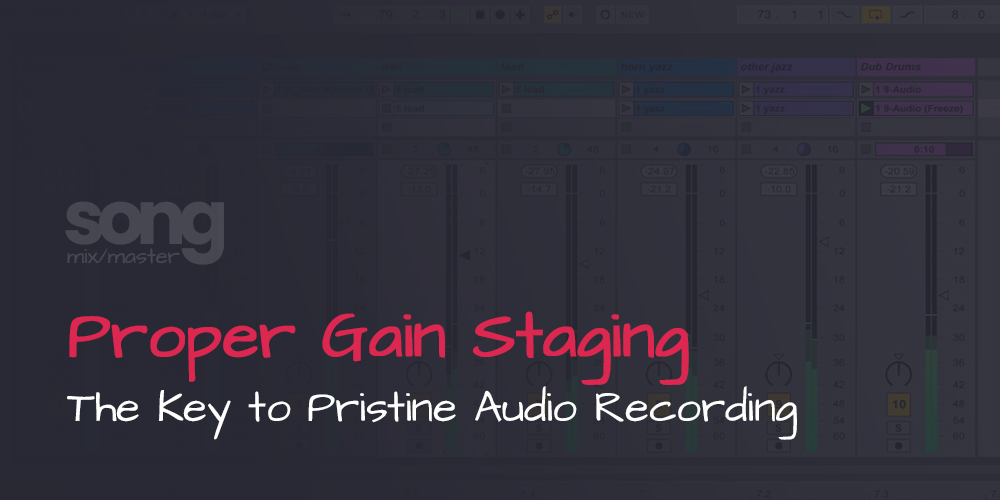In the realm of audio recording and production, achieving high-quality sound is paramount. Proper gain staging is a fundamental technique that can significantly impact the sonic integrity of a recording.
In this article, we’ll delve into the concept of gain staging, explain what it is, provide an example, and discuss its necessity and benefits in modern recording.
What Is Proper Gain Staging?
Gain staging is the process of setting the levels of audio signals at each stage of the audio signal path to optimize the signal-to-noise ratio and prevent distortion.
In simpler terms, it’s about managing the volume or gain of audio signals as they pass through various components of the recording and mixing chain.
Effective gain staging ensures that the audio signal remains within the optimal operating range of each device, from the microphone preamp to the digital audio workstation (DAW) and finally, to the master output.
It’s a meticulous balancing act that contributes to a cleaner, more transparent, and professional sound.
An Example of Gain Staging
Let’s take a practical example to illustrate gain staging:
Recording Vocals: Imagine you’re recording a vocalist in your studio. Here’s how gain staging would apply:
- Microphone Preamp: Begin by setting the gain on your microphone preamp. This is the first stage where the raw audio signal is captured. Adjust the preamp gain so that the vocalist’s performance is adequately captured without clipping or overloading the preamp. Clipping at this stage can introduce irreversible distortion.
- Audio Interface: If you’re using an audio interface, ensure that the input level on the interface is set appropriately. Avoid overloading the input and maintain a healthy input level to prevent digital distortion.
- Digital Audio Workstation (DAW): Inside your DAW, monitor the level of the recorded track. Ensure that the recorded signal doesn’t peak above 0 dBFS (decibels relative to full scale), which is the point of digital clipping. Leave enough headroom for mixing and processing.
- Plugins and Processing: As you apply effects and processing to the vocal track, monitor the levels within each plugin. Adjust parameters to avoid excessive gain changes that can introduce artifacts or unwanted coloration.
- Master Output: Finally, on the master output channel, maintain an appropriate level for your mix. Leaving some headroom here is crucial to prevent audio clipping when exporting your final mix.
Is Gain Staging Necessary?
Absolutely, gain staging is a necessary practice in audio recording and production for several reasons:
- Prevention of Distortion: Proper gain staging prevents distortion and clipping, which can irreparably damage audio signals and reduce audio quality.
- Optimal Signal-to-Noise Ratio: By setting appropriate levels at each stage, you maximize the signal-to-noise ratio, ensuring that your recordings are as clean and noise-free as possible.
- Consistency: Gain staging helps maintain consistency throughout the recording and mixing process, ensuring that your levels are manageable and predictable.
- Effective Use of Dynamic Range: It allows for the effective use of the dynamic range, preserving both the loud and soft elements of your audio signal.
- Compatibility: It ensures compatibility when sending tracks to other studios or collaborating with other musicians and engineers.
Benefits of Proper Gain Staging
Proper gain staging offers several benefits for modern recording:
- High-Quality Sound: It results in a cleaner, more transparent, and high-quality sound, which is especially important in genres where audio fidelity is paramount.
- Efficient Mixing: A well-gained staged recording is easier to mix. It allows for more precise control over audio levels and processing.
- Reduced Noise: It minimizes the noise floor, allowing your recordings to shine without unwanted hiss or background noise.
- Consistency: Gain staging ensures that your recordings are consistent and predictable, making it easier to work on projects over time.
In conclusion, proper gain staging is a fundamental practice in modern recording and production. It involves setting optimal levels at each stage of the audio signal path to maintain audio integrity, prevent distortion, and ensure the best possible sound quality.
Whether you’re recording vocals, instruments, or any other audio source, mastering this technique is essential for achieving professional results in the world of audio production.


Disclaimer: Any references to any brands on this website/webpage, including reference to products, trademarks, brands and companies, are provided for description purposes only. We don't have any association with or endorsement by these brands or companies. Some of the links on our blog may be affiliate links. This means if you click on these links and make a purchase, we may earn a commission at no extra cost to you.
Need Professional Mixing & Mastering?
You may also like to read...
How to Make FL Studio Run Faster on Your Computer
Versatile Brilliance On a Budget: sE’s DCM Series Microphones
Top 30 Best Mastering Audio Plugins In 2024
The Art of Song Mixing: Techniques for a Pro-Level Sound
How to Use a DAW: Tips for the Aspiring Professional
Audio Mastering with Artificial Intelligence: The Future of Sound